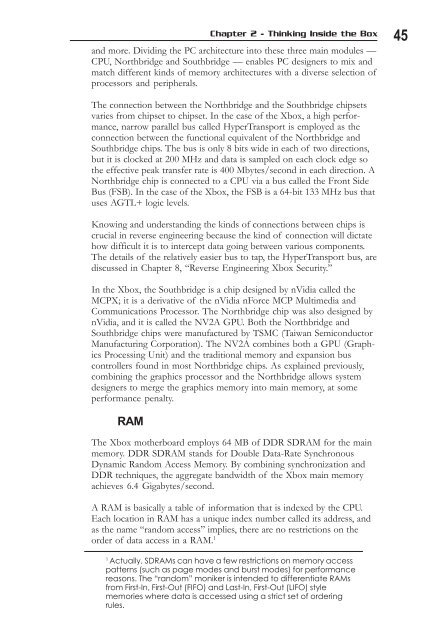Hacking the Xbox
Hacking the Xbox
Hacking the Xbox
You also want an ePaper? Increase the reach of your titles
YUMPU automatically turns print PDFs into web optimized ePapers that Google loves.
Chapter 2 - Thinking Inside <strong>the</strong> Box 45<br />
and more. Dividing <strong>the</strong> PC architecture into <strong>the</strong>se three main modules —<br />
CPU, Northbridge and Southbridge — enables PC designers to mix and<br />
match different kinds of memory architectures with a diverse selection of<br />
processors and peripherals.<br />
The connection between <strong>the</strong> Northbridge and <strong>the</strong> Southbridge chipsets<br />
varies from chipset to chipset. In <strong>the</strong> case of <strong>the</strong> <strong>Xbox</strong>, a high performance,<br />
narrow parallel bus called HyperTransport is employed as <strong>the</strong><br />
connection between <strong>the</strong> functional equivalent of <strong>the</strong> Northbridge and<br />
Southbridge chips. The bus is only 8 bits wide in each of two directions,<br />
but it is clocked at 200 MHz and data is sampled on each clock edge so<br />
<strong>the</strong> effective peak transfer rate is 400 Mbytes/second in each direction. A<br />
Northbridge chip is connected to a CPU via a bus called <strong>the</strong> Front Side<br />
Bus (FSB). In <strong>the</strong> case of <strong>the</strong> <strong>Xbox</strong>, <strong>the</strong> FSB is a 64-bit 133 MHz bus that<br />
uses AGTL+ logic levels.<br />
Knowing and understanding <strong>the</strong> kinds of connections between chips is<br />
crucial in reverse engineering because <strong>the</strong> kind of connection will dictate<br />
how difficult it is to intercept data going between various components.<br />
The details of <strong>the</strong> relatively easier bus to tap, <strong>the</strong> HyperTransport bus, are<br />
discussed in Chapter 8, “Reverse Engineering <strong>Xbox</strong> Security.”<br />
In <strong>the</strong> <strong>Xbox</strong>, <strong>the</strong> Southbridge is a chip designed by nVidia called <strong>the</strong><br />
MCPX; it is a derivative of <strong>the</strong> nVidia nForce MCP Multimedia and<br />
Communications Processor. The Northbridge chip was also designed by<br />
nVidia, and it is called <strong>the</strong> NV2A GPU. Both <strong>the</strong> Northbridge and<br />
Southbridge chips were manufactured by TSMC (Taiwan Semiconductor<br />
Manufacturing Corporation). The NV2A combines both a GPU (Graphics<br />
Processing Unit) and <strong>the</strong> traditional memory and expansion bus<br />
controllers found in most Northbridge chips. As explained previously,<br />
combining <strong>the</strong> graphics processor and <strong>the</strong> Northbridge allows system<br />
designers to merge <strong>the</strong> graphics memory into main memory, at some<br />
performance penalty.<br />
RAM<br />
The <strong>Xbox</strong> mo<strong>the</strong>rboard employs 64 MB of DDR SDRAM for <strong>the</strong> main<br />
memory. DDR SDRAM stands for Double Data-Rate Synchronous<br />
Dynamic Random Access Memory. By combining synchronization and<br />
DDR techniques, <strong>the</strong> aggregate bandwidth of <strong>the</strong> <strong>Xbox</strong> main memory<br />
achieves 6.4 Gigabytes/second.<br />
A RAM is basically a table of information that is indexed by <strong>the</strong> CPU.<br />
Each location in RAM has a unique index number called its address, and<br />
as <strong>the</strong> name “random access” implies, <strong>the</strong>re are no restrictions on <strong>the</strong><br />
order of data access in a RAM. 1<br />
1 Actually, SDRAMs can have a few restrictions on memory access<br />
patterns (such as page modes and burst modes) for performance<br />
reasons. The “random” moniker is intended to differentiate RAMs<br />
from First-In, First-Out (FIFO) and Last-In, First-Out (LIFO) style<br />
memories where data is accessed using a strict set of ordering<br />
rules.


